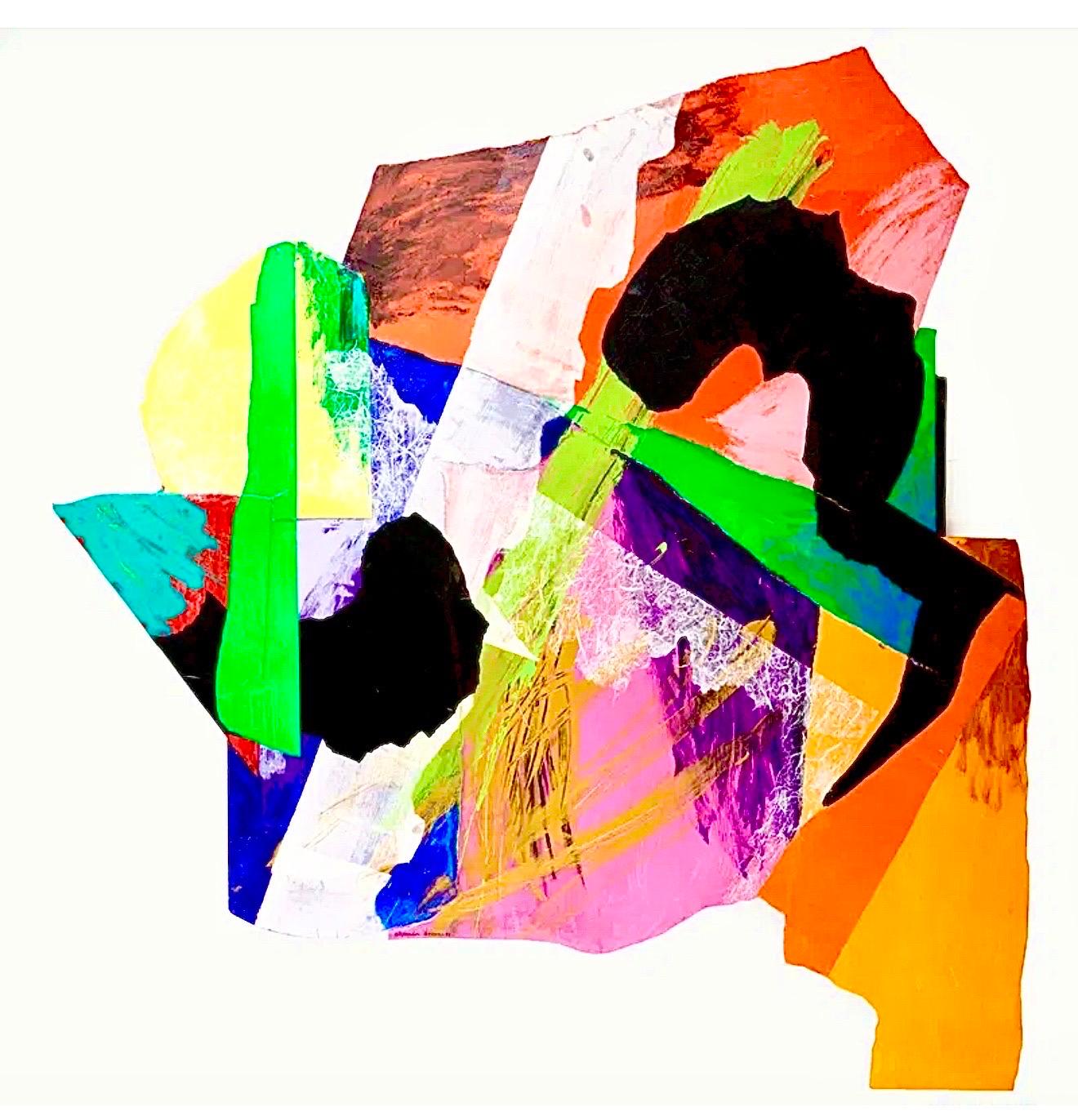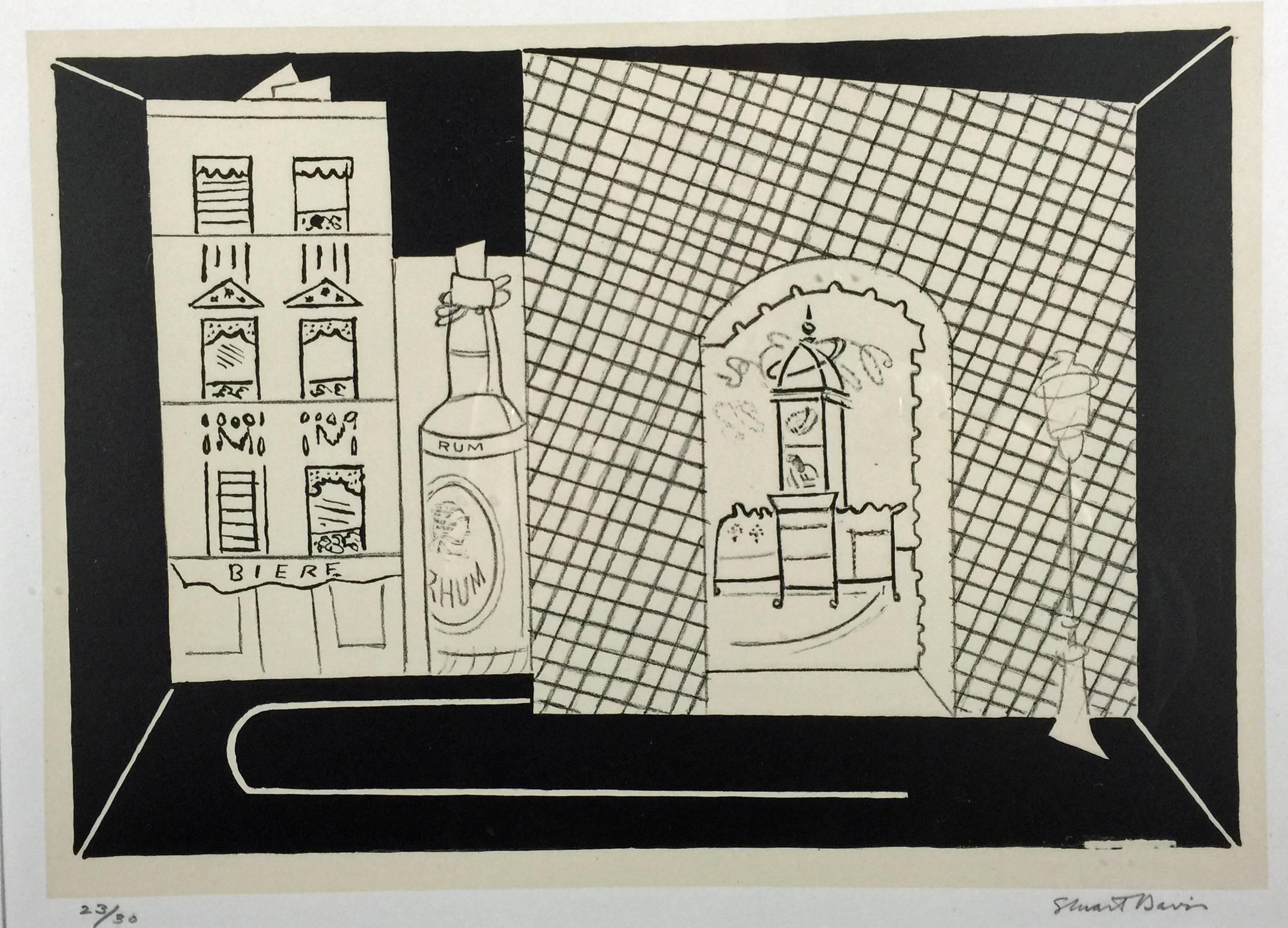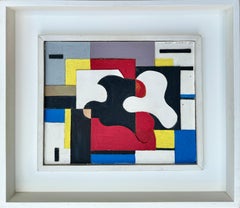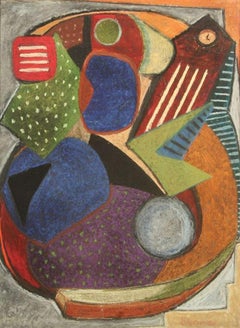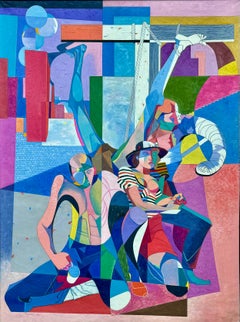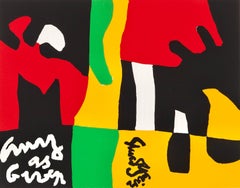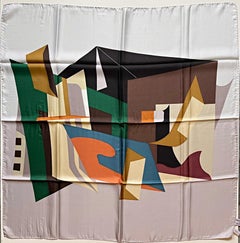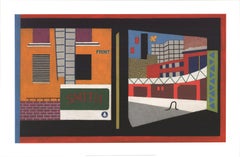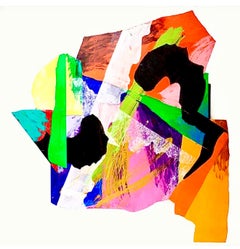Items Similar to "NY Street Signs" Mid-20th Century WPA 1938 Modernist Abstract Realism Pop Art
Want more images or videos?
Request additional images or videos from the seller
1 of 11
Stuart Davis"NY Street Signs" Mid-20th Century WPA 1938 Modernist Abstract Realism Pop Art1938
1938
$125,000
£93,966.99
€108,937.53
CA$174,519.45
A$195,471.02
CHF 101,710.07
MX$2,373,981.79
NOK 1,289,425.22
SEK 1,216,668.75
DKK 812,829.08
Shipping
Retrieving quote...The 1stDibs Promise:
Authenticity Guarantee,
Money-Back Guarantee,
24-Hour Cancellation
About the Item
"NY Street Signs" Mid-20th Century WPA 1938 Modernist Abstract Realism Pop Art
Stuart Davis (American, 1892-1964) "Street Signs" Modernist gouache and traces of pencil on paper in the proto-pop art style Davis is celebrated for, 1938, signed to lower right, framed. Image: 11 1/4 x 15 1/4 inches. Frame by Bark: 18 1/2 x 22 inches.
LITERATURE: A, Boyajian, M. Rutkowski, Stuart Davis, A Catalogue Raisonne, Vol. 2, New Haven, Connecticut, 2007, vol. II, p. 632, no. 1232, illustrated.
EXHIBITIONS: ACA Galleries, New York American Artists' Congress: Group Exhibition of Paintings and Sculpture, Dec. 3-16, 1939 (SDAB I, 12/3/39, p. 129). Outlines Gallery, Pittsburgh, Stuart Davis, Mar. 3-16, 1946. Coleman Art Gallery, Philadelphia, 5 Prodigal Sons: Former Philadelphia Artists: Ralston Crawford, Stuart Davis, Charles Demuth, Julian Levi, Charles Sheeler, Oct 4 - 30, 1947 (pamphlet), no. 12.
PROVENANCE: The artist; Mr. and Mrs. Frank Bowles, New York, Apr. 3, 1956; thence by descent, Private Collection, New York.
NOTES: According to the Catalogue Raissonne, "the title 'Street Signs' is recorded in the artist's account books (SDAB I, 12/3/39, p. 129; SDAB III. No. 89, 4/3/56, pp. 252-253), and in the Downtown Gallery's ca. 1946-56 stocklists and 4/3/56 purchase slip. Davis documents the completion of this work in his calendar entry, SDC 6.5.38, where he refers to this gouache with the working title: 'N.Y. Street Signs.'"
BIO
Admired for his artistic independence, brilliant use of color, and wit, Stuart Davis is regarded as one of the finest interwar modernists. The son of artist parents who met as students at the Pennsylvania Academy of the Fine Arts, he found his place amid the currents of twentieth-century American art earlier than some of his peers. Among his first art-world mentors were the artists known as The Eight and, later, the Ashcan School. At the time of his son's birth, Davis's father, an art editor, employed some of these artists at the Philadelphia Press and the family connection endured over subsequent years.
As a teenager, Davis left high school in New Jersey for New York City, where he received formal art training from 1910 to 1913 at the school founded by Robert Henri, artistic father of The Eight. Although Henri worked in a realist vein, he rejected academic idealism and urged his students to observe and sketch city life as experienced on streets and in music halls, taverns, and other locations. Davis lived in Newark during his art studies; in the dive bars he frequented, he developed an abiding passion for the technical precision and expressive spontaneity of jazz.
With his contribution of five watercolors, Davis was among the youngest participants in the seminal Armory Show (International Exhibition of Modern Art) in 1913, organized by a group of artists in order to introduce Americans to new developments in art across the Atlantic and at home. Excited by the formal innovations and bold use of color displayed by the European modernists, particularly Matisse, van Gogh, and Gauguin, Davis dedicated the next several years to becoming a modern artist.
By the early 1920s, Davis had left behind the representational realism of his early career. No matter how abstract his work became—and the degree of abstraction varied throughout his career—he always considered himself an observer of the world around him. In 1951, he expressed regret "that I have long been 'type-cast' as 'Abstract' because my interest in Abstractions is practically zero."(1) Instead, he identified his paintings as "Color-Space Compositions," in which areas of color define spatial relationships. Davis applied his formal concepts to subject matter ranging from still lifes, to landscapes, to commercial imagery and other aspects of urban life.
Just as a jazz musician riffs on snippets borrowed from popular music or explores all the permutations of a single phrase, so Davis drew from a personal well of reference points, remaking them into new images. In 1942 he remarked in his notebook: "I can work from Nature, from old sketches and paintings of my own, from photographs, and from other works of art. In each case the process consists of transposition of the forms of the subject into a coherent, objective color-space continuum, which evokes a direct sensate response to structure."
During Davis's own lifetime, his work was the subject of retrospectives at The Museum of Modern Art, New York (1945) and the Walker Art Center, Minneapolis (1957), and included in a wide variety of group exhibitions focusing on modern or abstract art. Sometimes identified as a forerunner of the next generation's Pop artists, Davis shared their engagement with American mass culture, if not their tendency to treat fragments of everyday life to iconic status. Instead Davis turned the stuff—objects, imagery, and language—of modernity into grace notes within his vivid impressions of urban experience. Keenly aware of his position as both participant in and chronicler of his cultural moment, he noted, "An artist who has traveled on a steam train, driven an automobile, or flown in an airplane doesn't feel the same way about form and space as one who has not."
- Creator:Stuart Davis (1892-1964, American)
- Creation Year:1938
- Dimensions:Height: 18.5 in (46.99 cm)Width: 22 in (55.88 cm)Depth: 1 in (2.54 cm)
- Medium:
- Movement & Style:
- Period:
- Condition:
- Gallery Location:New York, NY
- Reference Number:1stDibs: LU1156213415932
About the Seller
5.0
Gold Seller
Premium sellers maintaining a 4.3+ rating and 24-hour response times
Established in 2008
1stDibs seller since 2019
191 sales on 1stDibs
Typical response time: <1 hour
- ShippingRetrieving quote...Shipping from: New York, NY
- Return Policy
Authenticity Guarantee
In the unlikely event there’s an issue with an item’s authenticity, contact us within 1 year for a full refund. DetailsMoney-Back Guarantee
If your item is not as described, is damaged in transit, or does not arrive, contact us within 7 days for a full refund. Details24-Hour Cancellation
You have a 24-hour grace period in which to reconsider your purchase, with no questions asked.Vetted Professional Sellers
Our world-class sellers must adhere to strict standards for service and quality, maintaining the integrity of our listings.Price-Match Guarantee
If you find that a seller listed the same item for a lower price elsewhere, we’ll match it.Trusted Global Delivery
Our best-in-class carrier network provides specialized shipping options worldwide, including custom delivery.More From This Seller
View AllAbstract Cubist Construction Collage Mid 20th Century American Modernism Cubism
By Vaclav Vytlacil
Located in New York, NY
Abstract Cubist Construction Collage Mid 20th Century American Modernism Cubism
Vaclav Vytacil (1892 - 1984)
Abstract Construction #2
Caesin on board collage
11 x 13 1/2 th inches
S...
Category
1930s Abstract Abstract Paintings
Materials
Casein, Board
Abstract Mid 20th Century WPA Non Objective American Modernism New Hope Modern
By Louis Stone
Located in New York, NY
Abstract Mid 20th Century WPA Non Objective American Modernism New Hope Modern.mixed media. 21 x 16 (sight). Housed in a hand carved frame.
Louis King Stone ...
Category
1940s American Modern Mixed Media
Materials
Gouache, Board
Abstract American Modernism Mid-Century WPA Era Drawing Woodstock 20th Century
By Konrad Cramer
Located in New York, NY
Abstract American Modernism Mid-Century WPA Era Drawing Woodstock 20th Century, Sight size is 16 x 12 inches. The drawing is currently at the framers. A photo will be posted asap.
A...
Category
1930s Abstract Abstract Drawings and Watercolors
Materials
Paper, Ink, Watercolor
Figurative Cubist Surrealist Abstraction Mid 20th Century American Modern Large
By O. Louis Guglielmi
Located in New York, NY
Figurative Cubist Surrealist Abstraction Mid 20th Century American Modern Large
O. Louis Guglielmi (1906 - 1956)
OBSESSIVE THEME
44 x 33 inches
Oil on canvas
Signed and dated '48 lo...
Category
1940s American Modern Abstract Paintings
Materials
Canvas, Oil
MODERNIST ABSTRACT Mid-Century New Hope Non-Objective oil American Modern WPA
By Louis Stone
Located in New York, NY
MODERNIST ABSTRACT Mid-Century New Hope Non-Objective oil American Modern WPA
Louis Stone (1902-1984) "Abstract," 16 X 12 inches. Oil on canvas, signed lower right.
An abstract pai...
Category
1940s Abstract Abstract Paintings
Materials
Canvas, Oil
The New Cable British Modern Mid 20th Century Vorticist European Vorticism Woman
By Sybil Andrews
Located in New York, NY
The New Cable British Modern Mid 20th Century Vorticist European Vorticism Woman
Sybil Andrews CPE (British/Canadian, 1898-1992)
"The New Cable," 1931
12 x 16 1/2 inches
Color linocut
Signed, titled, inscribed 'Second State', and numbered 13/60 in pencil
Framed: 19 x 24 inches
Literature: Coppel Sa17
Illustrated on page 10 of the catalog
The proposed edition of the first state of the Giant Cable was 50, but only 30 impressions were pulled. Andrews removed the blue background for the second state, which was published under the title The New Cable in an edition of 60.
BIO
Sybil Andrews was a printmaker, painter, graphic artist and educator who was born in Bury St. Edmonds, Suffolk, England. She moved to London (England) in 1922. In 1947, she emigrated to Campbell River (Vancouver Island) British Columbia, Canada, where she worked, taught and lived for the rest of her life. She died at a hospital in Victoria (B.C.)
Her mediums were the colour linocut (1) (most famous), etching, posters, pastels, ink, watercolour, monoprint and oil. Her subjects were human activity (at work, sports, travel, etc.), figures, animals, genre, allegory, architecture and landscape. Her style was Art Deco (see AskART styles), Futurism, Cubism and Vorticism (2). Her work is identified by a simple format, clean lines, distortion, vivid colours, drama and rhythm.
Quote: "The colour linocut was just the medium for me, being interested in dynamics and ideas and patterns... It is impossible to be fussy with lines, you have to simplify, you are forced to simplify your idea to its fundamentals." Andrews produced 76 linocuts in her life, of which 43 were made from 1929 to 1939, which is considered to be her best period.
John Hassall's art correspondence course (1918) was the beginning of her formal art education. She went from there to Heatherley's School of Fine Art (London/1922) where she studied under Henry Massey (see AskART) and met artistic partner Cyril Power (see AskART). At the same time, she studied independently with sculptor Henri Glicenstein (see AskART) who taught her drypoint etching and to draw from life.
She also attended the Grosvenor School of Modern Art (1925). Iain McNab (1890-1967) was Principal and Claude Flight (3) (see AskART) an instructor who had a great influence on her choice of linocut as a primary medium. Some of his other students and her associates were Edith Lawrence (1890-1973), Lill Tschudi (1911-2001), Eileen Mayo (see AskART) and William Greengrass (1896-1970). After emigrating to Canada she taught art continuously until a month before her death.
She was elected a member of the Canadian Painters - Etchers Society (after 1976 the Print and Drawing Council of Canada) in 1951.
She began exhibiting her work in 1921.In 1929 she was included in "The First Exhibition of British Linocuts...
Category
1930s Modern Figurative Prints
Materials
Linocut
You May Also Like
Composition (Cole/Myers 79), X + X, Ten Works by Ten Painters, Stuart Davis
By Stuart Davis
Located in Auburn Hills, MI
Silkscreen on Mohawk Superfine Bristol paper. Inscription: unsigned and unnumbered, as issued. Good condition. Notes: From the folio, X + X, Ten Works by Ten Painters, 1964. Publishe...
Category
1960s American Modern Landscape Prints
Materials
Screen
$1,996 Sale Price
20% Off
Free Shipping
Eggbeater 1: 34 Square inch Limited Edition Silk Scarf, for the Whitney Museum
By Stuart Davis
Located in New York, NY
Stuart Davis
Eggbeater No. 1 Silk Scarf, ca. 1980
100% silks scarf
34 × 34 inches (the smaller measurements shown are after the scarf is folded, to minimize shipping costs, as it sh...
Category
Mid-20th Century American Modern Abstract Prints
Materials
Silk, Screen
Stuart Davis 'House and Street'- Offset Lithograph
By Stuart Davis
Located in Brooklyn, NY
Paper Size: 22.25 x 34.25 inches ( 56.515 x 86.995 cm )
Image Size: 18.25 x 30 inches ( 46.355 x 76.2 cm )
Framed: No
Condition: A-: Near Mint, very light signs of handling
S...
Category
1990s Prints and Multiples
Materials
Offset
Large Modernist Alexander Liberman Contemporary Mixed Media Painting Svet III
By Alexander Liberman
Located in Surfside, FL
Alexander Liberman (1912-1999): Svet III
Mixed media on board, 1984, signed 'Alexander Liberman' and dated at bottom=
Hand signed, titled and dat...
Category
1980s Abstract Abstract Paintings
Materials
Masonite, Mixed Media
ARCH NO. 1
By Stuart Davis
Located in Portland, ME
Davis, Stuart. ARCH NO. 1. Lithograph, 1929. Edition of 30. Numbered "23/30" and signed in pencil. 8 3/4 x 13 inches, 225 x 275 mm. In excellent condition.
Category
American Modern Landscape Prints
Materials
Lithograph
$8,500
Mid Century Modernist NYC Cubist Abstract Large Framed Exhibited Oil Painting
Located in Buffalo, NY
Antique American abstract cubist composition "Terra Firma Theme 10" by Augustus Goertz (Born 1948) . Oil on canvas, circa 1958. Housed in a period gi...
Category
1950s Cubist Abstract Paintings
Materials
Canvas, Oil
More Ways To Browse
Used Street Sign
Used Street Signs
Abstract Realism
Dive Bar
Midcentury Pop Art
Artist Davis
Wpa Sign
Realism Painting Mid Century
Early 20th Century Realism Paintings
Mid Century Modern Pop Art Paintings
Early 20th Century Pencil Sketch
American Express Train
Vintage Airplane Art
Tavern Sign
Wpa Still Life
Steam Train
Proto Modern
Wpa Art Charles



